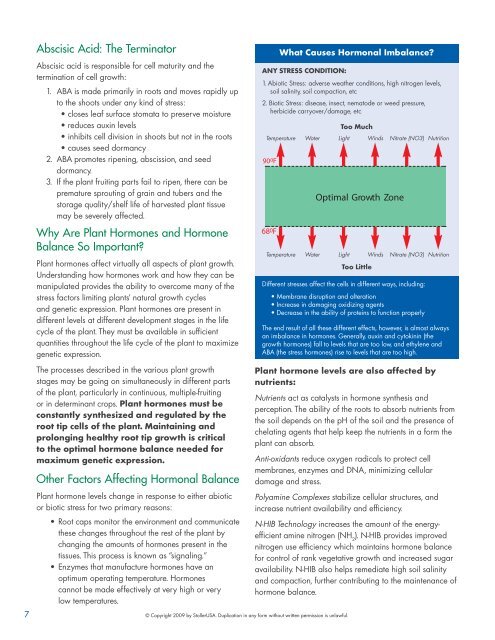Create successful ePaper yourself
Turn your PDF publications into a flip-book with our unique Google optimized e-Paper software.
7<br />
Abscisic Acid: The Terminator<br />
Abscisic acid is responsible for cell maturity and the<br />
termination of cell growth:<br />
1. ABA is made primarily in roots and moves rapidly up<br />
to the shoots under any kind of stress:<br />
• closes leaf surface stomata to preserve moisture<br />
• reduces auxin levels<br />
• inhibits cell division in shoots but not in the roots<br />
• causes seed dormancy<br />
2. ABA promotes ripening, abscission, and seed<br />
dormancy.<br />
3. If the plant fruiting parts fail to ripen, there can be<br />
premature sprouting of grain and tubers and the<br />
storage quality/shelf life of harvested plant tissue<br />
may be severely affected.<br />
Why Are <strong>Plant</strong> Hormones and Hormone<br />
Balance So Important?<br />
<strong>Plant</strong> hormones affect virtually all aspects of plant growth.<br />
Understanding how hormones work and how they can be<br />
manipulated provides the ability to overcome many of the<br />
stress factors limiting plants’ natural growth cycles<br />
and genetic expression. <strong>Plant</strong> hormones are present in<br />
different levels at different development stages in the life<br />
cycle of the plant. They must be available in sufficient<br />
quantities throughout the life cycle of the plant to maximize<br />
genetic expression.<br />
The processes described in the various plant growth<br />
stages may be going on simultaneously in different parts<br />
of the plant, particularly in continuous, multiple-fruiting<br />
or in determinant crops. <strong>Plant</strong> hormones must be<br />
constantly synthesized and regulated by the<br />
root tip cells of the plant. Maintaining and<br />
prolonging healthy root tip growth is critical<br />
to the optimal hormone balance needed for<br />
maximum genetic expression.<br />
Other Factors Affecting Hormonal Balance<br />
<strong>Plant</strong> hormone levels change in response to either abiotic<br />
or biotic stress for two primary reasons:<br />
• Root caps monitor the environment and communicate<br />
these changes throughout the rest of the plant by<br />
changing the amounts of hormones present in the<br />
tissues. This process is known as “signaling.”<br />
• Enzymes that manufacture hormones have an<br />
optimum operating temperature. Hormones<br />
cannot be made effectively at very high or very<br />
low temperatures.<br />
<strong>Plant</strong> hormone levels are also affected by<br />
nutrients:<br />
© Copyright 2009 by StollerUSA. Duplication in any form without written permission is unlawful.<br />
What Causes Hormonal Imbalance?<br />
ANY STRESS CONDITION:<br />
1. Abiotic Stress: adverse weather conditions, high nitrogen levels,<br />
soil salinity, soil compaction, etc<br />
2. Biotic Stress: disease, insect, nematode or weed pressure,<br />
herbicide carryover/damage, etc<br />
Too Much<br />
Temperature Water Light Winds Nitrate (NO3) Nutrition<br />
900F<br />
680F<br />
Optimal Growth Zone<br />
Temperature Water Light Winds Nitrate (NO3) Nutrition<br />
Too Little<br />
Different stresses affect the cells in different ways, including:<br />
• Membrane disruption and alteration<br />
• Increase in damaging oxidizing agents<br />
• Decrease in the ability of proteins to function properly<br />
The end result of all these different effects, however, is almost always<br />
an imbalance in hormones. Generally, auxin and cytokinin (the<br />
growth hormones) fall to levels that are too low, and ethylene and<br />
ABA (the stress hormones) rise to levels that are too high.<br />
Nutrients act as catalysts in hormone synthesis and<br />
perception. The ability of the roots to absorb nutrients from<br />
the soil depends on the pH of the soil and the presence of<br />
chelating agents that help keep the nutrients in a form the<br />
plant can absorb.<br />
Anti-oxidants reduce oxygen radicals to protect cell<br />
membranes, enzymes and DNA, minimizing cellular<br />
damage and stress.<br />
Polyamine Complexes stabilize cellular structures, and<br />
increase nutrient availability and efficiency.<br />
N-HIB Technology increases the amount of the energyefficient<br />
amine nitrogen (NH 2 ). N-HIB provides improved<br />
nitrogen use efficiency which maintains hormone balance<br />
for control of rank vegetative growth and increased sugar<br />
availability. N-HIB also helps remediate high soil salinity<br />
and compaction, further contributing to the maintenance of<br />
hormone balance.


